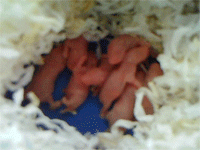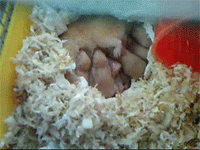| |
How to raise baby hamsters.
 |
A nest of new born pups |
As our beloved hamsters’ pregnancy draws to a close we wait in anticipation and excitement of the expected arrival of the new born pups. But not many people will see the wonderful events of the birth unfold, as the female usually gives birth in the middle of the night as we all sleep. Even if we stayed up all night the actual birth may still not be witnessed as most females give birth to the pups in the nest and out of view. As a breeder, and with the hundreds of births that have occurred over the years, I have actually seen very few hamsters giving birth. So many times I have left video cameras running 8-10 hours during the night to capture the miracles of the birth unfold, only to be disappointed when the female is sat in a very deep nest and all is concealed from view. The first view I get of the pups is when mum leaves the nest briefly to feed or drink; even then she may cover them with the nesting material before leaving them. Some females may have them on the floor dotted around her cage, but this is a very are occasion. When she has done she will gather them all up in turn and take them to the nest for their first feed
 |
Baby hamsters suckling from the mother |
Hamster milk
The biggest danger to the newborn pups is exposure to infection. But thankfully nature has provided a particular substance to ensure the new born pups can withstand any threat from infection. It is Colostrum: Colostrum, or beestings as it may be known, is the milk produced by the lactating female to feed her new born offspring’s. Once the first milk is ingested by the young newborn pups it performs numerous tasks. The first aim of colostrum is to provide the young with sustenance as it is high in protein and energy. Colostrum is also known to contain antibodies, and the second purpose of colostrum is to provide the newborn with a passive immune system. All new born hamster pups are born without an active immune system of their own. They acquire what is known as a passive immune system: This is where antibodies are passed onto the pups from another source other than their own, this being the mother. This type of immunity however is only temporary until the young pups' develop their own immune system. So in effect the mother transfers antibodies to the young pups via her milk. The colostrum coats the intestines and digestive system protecting them from deadly bacteria and viruses.
As much as we would all like to participate in the joy of rearing these cute little balls of fur, there is only so much human intervention the mother will tolerate before she becomes fearful for the safety of her babies while they are still in the nest. We must bear in mind these animals follow an inborn pattern of behavior inherited from their wild ancestors and that is to safeguard the survival of their species. Intervening too soon may cause her to become anxious and she may try to move the litter and nest to another location, or worse still abandon them. So it is better to leave her alone while the pups are still very young, as mummy knows best. As their eyes begin to open at around 14 days old the mother will become more tolerant of you handling the pups at this age.
 |
Babies eating solid food |
Weaning baby hamsters
At around 7 days old the mother starts the weaning process. This is when she will begin to reduce the amount of milk she feeds them. By the time they are 18-21 days old the baby hamsters will be fully weaned off mum’s milk. Baby hamsters are born with teeth, and at about 7 days old she will start taking solid food to the nest for the babies to eat as they start to become less dependent on her milk. This is the time now you can start feeding them more high protein foods. If you wish to take an active part in feeding the pups then chop up some boiled egg carrots and corn (fresh corn) a little cucumber and some cauliflower (florets only, no green leaf ) diced up finely and sprinkle it into the nest of pups. Also put some into the food bowl so mum can put this in her store for the pups feed later in the day, and of course, for herself as well. See video opposite of 8 day old pups beginning to eat solid food.
Once the babies have finished weaning at 18-21 days we can now do our little bit to ensure the pups grow into healthy and socialized individuals. The bigger they get the more they are going to eat so make sure there is plenty of food for all the pups and mum.
Rearing Baby Hamsters
|
|


